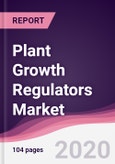What is plant growth regulator?
Plant growth regulators are the synthetic or natural chemicals that are responsible in controlling the growth and development of the plant. Natural plant growth regulators are produced with in specific parts of plants in minimal qualities and migrate to other parts, manipulating several physiological functions to regulate the plant’s growth such as promoting plant cell division and cell expansion, leaf expansion, retarding senescence of the leaves, ripening of fruits & vegetables, fruit & flower maturation, and seed germination. The major types of plant growth regulators are cytokinins, auxins, gibberellins, ethylene and abscisic acid.
What are the major applications for Plant growth regulator?
The various end users assessed include fruits & vegetables, turf & ornamental, cereals & grains, oil & seeds, and others. The major fruits that utilize PGR are apples, banana, grapes, mango, litchi, water melon, pine apple, kiwi and others. Vegetables like cucumber, lettuce, spinach, cabbage, pumpkin and others use these plant growth regulators. The main objective for the application of PGR in fruits and vegetables is to support their ripening. This is achieved by ethylene which is also called as ripening hormone.
The turf and ornamentals segments comprises of turf grass, nursery plants, ornamental plants, ornamental flowers, woody ornamentals, bedding plants, green house plants and others. In lawn and turf grass management, PGRs have applications in initiating and maintaining turf growth, preventing change in the color of the grass during conditions of cold stress, reducing mowing frequency, increasing plant thickness and limiting vegetative growth there by improving the quality of turf.
Plant Growth Regulators Market
Market Research and Market Trends of Plant Growth Regulators Market
RIO, which is developed from natural plant sources, boosts natural plant hormone activity and allows plants to develop more effectively. Environmental Protection Agency has recently approved this bio stimulant from Arysta Life Science, North America which activates endogenous natural plant hormone activity for enhanced plant reproductive growth.
Companies into the manufacturing of PGRs are continuously looking for versatile solutions. One such versatile plant growth regulator is Ethrel. It improves coloration and accelerates uniform ripening of fruits. Moreover it can also applicable for specific uses that include defoliation in pomegranate and breaking alternate bearing in mango, etc.
Who are the Major Players in Plant growth regulators Market?
The companies referred in the market research report include the BASF, DOW Chemical, FMC Corporation, Nufarm, Syngenta and others.
What is our report scope?
The report incorporates in-depth assessment of the competitive landscape, product market sizing, product benchmarking, market trends, product developments, financial analysis, strategic analysis and so on to gauge the impact forces and potential opportunities of the market. Apart from this the report also includes a study of major developments in the market such as product launches, agreements, acquisitions, collaborations, mergers and so on to comprehend the prevailing market dynamics at present and its impact during the forecast period 2018-2023.
Key Takeaways from this Report
- Evaluate market potential through analyzing growth rates (CAGR %), Volume (Units) and Value ($M) data given at country level – for product types, end use applications and by different industry verticals.
- Understand the different dynamics influencing the market – key driving factors, challenges and hidden opportunities.
- Get in-depth insights on your competitor performance – market shares, strategies, financial benchmarking, product benchmarking, SWOT and more.
- Analyze the sales and distribution channels across key geographies to improve top-line revenues.
- Understand the industry supply chain with a deep-dive on the value augmentation at each step, in order to optimize value and bring efficiencies in your processes.
- Get a quick outlook on the market entropy – M&A’s, deals, partnerships, product launches of all key players for the past 4 years.
- Evaluate the supply-demand gaps, import-export statistics and regulatory landscape for more than top 20 countries globally for the market.
Table of Contents
Methodology

LOADING...








